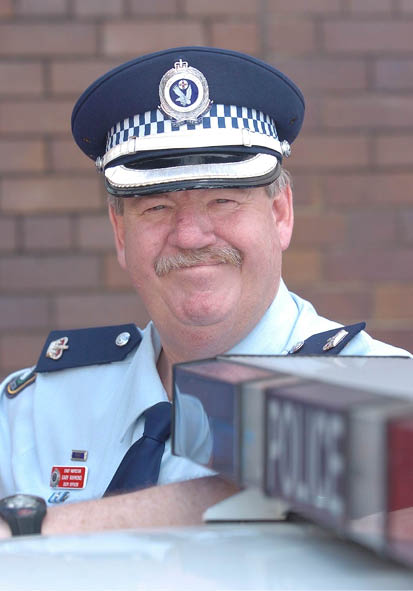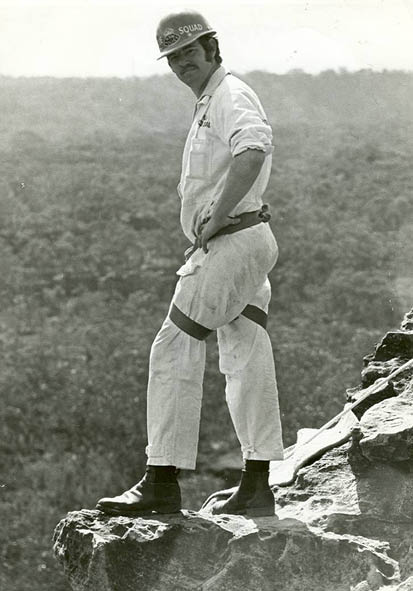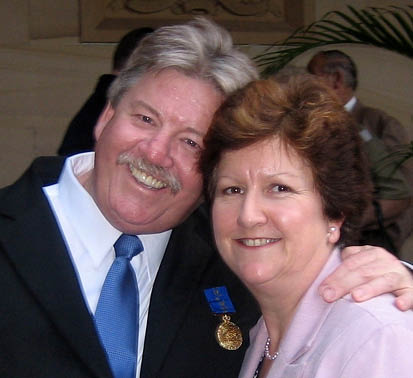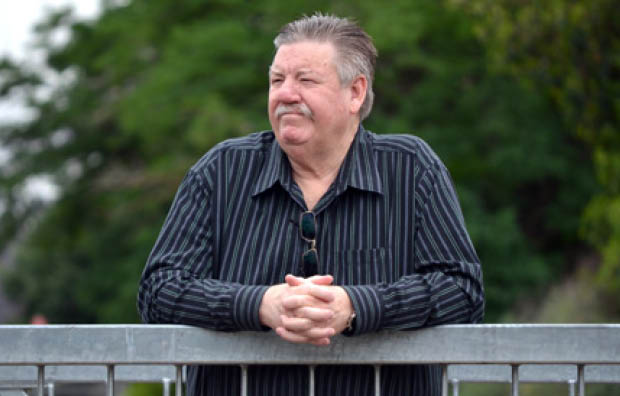JOHN McNAMEE talks to an inspirational former police officer who was present at some of our worst tragedies
The side of the train and windows had burst open from the weight of the bridge, as if it had been ripped apart by a huge can opener.
The police rescue team knew they had to gain access to the crushed carriages sideways between the collapsed bridge girders.

Gary Raymond as a Senior Police Officer…..received numerous citations for bravey
There was chaos everywhere as emergency workers and volunteers tried to rescue the injured and free the dozens of trapped bodies.
Many people, some with children on their laps, had been crushed to death lying forward in their seats.
Constable Gary Raymond from the NSW Police Rescue Unit had been instructed by his senior officer to crawl into the wreckage to see if he could retrieve any of the wounded who were still alive.
It was a scene from hell. Crushed bodies were lying everywhere and the moans of the injured could be heard coming from all over the darkened, debris-strewn ruins of the train.
It was the morning of January 18, 1977 when the 6.09am train from Mount Victoria to Central Station crashed into the Bold St bridge stanchions at Granville station in western Sydney bringing down thousands of tons of twisted steel and shattered concrete on to the crowded passenger carriages.
As Gary Raymond crawled his way through the wreckage he came across a young woman who he thought must have been killed as she was lying under a pile of debris. Her face was purple, her tongue was sticking out and she appeared lifeless. Gary checked the carotid artery in her neck and found she still had a feeble pulse even though she was not breathing.

Gary Raymond as a member of the NSW Police Rescue squad in 1977 prepares for a dramatic police rescue
In a book , Top Cop, written many years later about Gary’s life as a former paramedic, rescue squad officer and detective, it describes the horrific scene involving the woman, Debbie Skow: “Her airway was blocked due to her head being twisted and compressed on to her chest……. Gary knew that if he moved her head the wrong way it may sever her spinal cord. That would either kill her or she would become a quadriplegic.
“Gary had no choice as she wasn’t breathing. …..In the confined space he lifted and rotated her head backwards with traction and lifted her jaw to open her airway.
“Miraculously Debbie started to breathe, her colour returned although she remained unconscious…”
Gary and his colleagues and ambulance and fire brigade crews went on to help rescue many more of the passengers in that tragedy in which 83 people died and more than 200 were injured.
Debbie Skow and her friend Erica Watson who was also rescued from the rubble by Gary, appeared many years later on the TV series Where Are They Now, with their children, where they were emotionally reunited with the former rescue squad hero.
“Well it was always the training I had as a paramedic which helped me in a lot of these situations,” Gary told Go55s.
“In fact I started off at an early age becoming a volunteer St John’s Ambulance cadet at age 9 and when I was 16 and living in New Lambton near Newcastle I helped save the life of a man who had been critically injured in a car crash.
“I was on the scene and noticed that he was bleeding from the ear and gurgling and I suspected he’d fractured the base of his skull. I log-rolled him gently on to his side and formed a makeshift cervical collar of bandages and a newspaper to support his neck.
“When the ambulance crew arrived they were amazed and said I’d saved the man’s life. They later invited me into their station and showed me around and it was then I knew I wanted to be a paramedic,” Gary said.
Some years later he joined the NSW police force with two of his brothers Neil and Kevin and began a long career as a rescue squad officer performing 1500 rescues of which 1000 were motor vehicle collisions, 200 vertical rescues and 200 suicide crisis negotiation retrievals.
He’s attended multiple disaster scenes from the Hilton Bombing, the Luna Park Ghost trains fire in which 6 children and one adult died, the Newcastle earthquake and was there in 1997 when they pulled Stuart Diver out of his snow “tomb” at the Thredbo landslide disaster.
“I suppose one of the most dangerous retrievals I ever did was abseiling down a 30 metre cliff face at the Gap at Sydney Heads to retrieve the body of a man who had jumped to his death.
“There was a huge sea running and windy conditions and as they lowered me down with a ladder- stretcher the force of the surging waves kept slamming me up and down the jagged cliff face and at one stage I had to use the man’s body as a sort of shock absorber underneath me as I plunged down towards the rock platform. Wow, it was pretty scary alright,” Gary says.
After his spectacular rescue squad career Gary became a designated detective and was involved in investigating such major crimes as the brutal rape and mutilation slaying of nursing sister Anita Cobby, the murder of five-year-old Tess Debrincat, the assassination of Cabramatta MP John Newman and the Doonside car bomb explosion.
Gary admits that it was his involvement in hunting down the callous killers of Anita Cobby in February 1986 that gives him a great amount of satisfaction.
“Nobody could believe the horrific injuries inflicted on this person, it was exceedingly brutal and almost animalistic, well, even animals don’t kill for the thrill of it as her murderers did,” Gary said.
“She was still conscious and fighting as they slashed her throat, the wounds on her arms and hands testify to that.
“But despite the dreadful shock of it all, it was an investigation which ultimately led to the arrest and conviction of these five killers who are never to be released.
“During that time I worked with a totally dedicated group of detectives, some of whom were seriously traumatised by the events…one day I saw a fellow officer punching both fists into his locker door out of bitter frustration. His hands were a mess until I stopped him.

Gary Raymond with wife of 35 years Michelle receiving the NSW Police Medal in 2004.
“It was also Anita’s wonderful parents Garry and Grace Lynch, who were inspirational in their terrible grief, how they helped us in our inquiries, how they suffered when they saw Anita’s tortured body lying in the morgue. How brave they were,” Gary remembers.
Now retired but with a multitude of police and community support roles, Gary credits his deep Christian faith and his long-time career as a Salvation Army officer which he shares with his wife Michelle, as helping him cope with the traumas he faced throughout his working life.
His many roles include being a motivational speaker, disaster survival advisor, suicide counsellor and a member of the Homicide Victims Support organisation. He also addresses such groups as Probus on the life of the everyday police officer.
His latest project is the building of a memorial refuge in Doonside in Sydney’s outer west for the victims, adults and young children, who suffer the trauma of a family homicide.
It will be called “Grace’s Place” after Anita Cobby’s late mother.
“We were surprised at the huge support we got from the police service and all through the community for this wonderful project,” Gary said.
During his 33 year police career in which he rose to the rank of Chief Inspector, Gary now in his late 60s, had an enigmatic nickname…the Pink Panther.
“OK Gary come clean, why that name,” I ask him.
“Well when I was trying to approach someone who was threatening to jump out of a window, or over a cliff, or during a drug bust, I’d take my big thumping police boots off and try to sneak up on them and hence the Pink Panther name,” Gary laughs.
HONOURS AND AWARDS OF GARY RAYMOND OAM.
- The Australian Police Medal.
- The Order of Australia Medal.
- The National Police Service Medal.
- The National Medal with Clasp.
- The NSW Police Medal with 30-year Clasp.
- 2002 National Award of Excellence in Critical Incident Stress Management.
- Nominated for Police Officer of the Year.
- Nominated for Australian of the Year 2007, 2012, 2014.
- The NSW Police Medal 2004.
- Numerous citations for brave conduct.
Any organisation wishing to engage Gary Raymond as a guest speaker or wanting to get more information on the Homicide Victims Support Group can contact him on email garyraym@ozemail.com.au
Main pic: Gary Raymond in plain clothes as a senior detective….he was involved in dozens of tragic investigations




